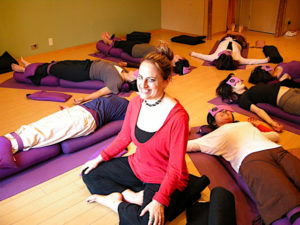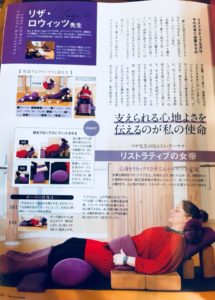by Leza
I never thought I’d open a yoga studio, let alone do so in a foreign country. Twenty-five years ago, when I was at a meditation retreat in Haiku, Hawaii and a voice saying “You need to open a yoga studio in Tokyo” echoed in my brain, I pushed the voice aside. I had no intention of returning to Tokyo, where I’d once lived. California had made mush of me in the best possible way, and there was no going back. Or so I thought, until my Japanese husband said he had to return to Japan take care of his elderly father. Would I go with him?
I didn’t want to go, but I loved my husband and I wanted to be with him. I was nervous, and wondered what would I do there, now that I was in my forties. Before, I had taught English and was a freelance writer—a good life for someone in her twenties. Then I remembered the voice in Hawaii. I Googled “yoga studios in Tokyo.” Just two came up.
I knew that while Japanese culture is built around calm and nature, people there have largely forgotten this, especially in fast-paced, crowded cities of almost 14 million people, like Tokyo. So I made up my mind. I decided to open a yoga studio there and to teach Restorative Yoga, a practice I had found deeply healing and rejuvenating when I moved back to America after years abroad.
In California, when I had been an expat in my body, Restorative Yoga brought me home again. So I had taken Restorative Yoga classes in Northern California for a decade, and I had taught it for years before attending Judith Laster’s teacher training and getting certified. I was smitten. I knew this practice would be so needed in stressed-out Tokyo. So I bought thirty yoga bolsters, blankets, five-pound sandbags, neck pillows, and eye bags. As we flew over the Pacific to Japan, the props sailed on a slow boat to Yokohama in a shipping container.
Since I didn’t have anywhere to put them when they arrived, I knew I needed to open the yoga studio quickly. After a few months of searching, my husband and I found a small, airy room in an old building which been on the market a year because of a large credenza in the space. This deal-breaker for others was perfect for us—a place to store the props. In California, we’d been living surrounded by nature. In Tokyo, there was not much green outside of a cup of tea. I wanted the studio to be a calm oasis with a round moon-window shape. We brought some bamboo from my husband’s family garden into the space, bringing the outside in. I, too, was an outsider, coming into a famously closed society. Would there be room for me and Restorative Yoga here?
We were ready to open, but the props were held up. Customs had to check every sandbag for drugs. I opened the studio anyway. No one came at first. I tried to trust the voice. After all, it was in Haiku that I’d heard it. Japan was the birthplace of haiku. The gods had to be happy, I told myself. Day after day, I did yoga in the quiet, calm space. Alone. Embracing the nobility of failure, like a samurai. Then one day, I got it: I’d been waiting for others to come, but I hadn’t fully arrived myself. So I practiced, fully and deeply, just for me. With gratitude and self-compassion. And then, my first student came. She told others, and more students arrived, bringing friends and co-workers. Because the props weren’t there yet, I taught Vinyasa Flow and Yin Yoga. And I offered community classes for charity. I was warned that community charity classes wouldn’t fly in status-conscious Japan. I did not listen.
Finally, the props arrived, and fit into the credenza perfectly. None of the students had ever done Restorative Yoga before, and all reported feeling a sense of peace and relaxation they had never experienced. I was challenged by famous Ashtanga yogis in Japan for teaching “fake yoga” because I had people lie around on bolsters and blocks. I didn’t listen. Soon we had a sangha, and I had a new home an ocean away from where I was born.
Over the decades, I trained thousands of teachers in Restorative Yoga all over Japan and in other Asian countries, too, helping to share this healing practice with tens of thousands of people. And when the massive earthquake and tsunami struck the Tohoku Coast in 2011, teachers I had trained in those areas offered comfort and healing to their stricken communities. Eventually, the male Ashtanga teachers who had vociferously criticized me got injured, grew old, or simply wised up. They started to practice Restorative Yoga, too, and eventually to teach it.
Yoga Journal Japan did a profile of me and showed me doing my very favorite restorative pose, Empress pose. I felt like I’d become the Restorative Yoga Empress of Japan.

I learned so much by opening a yoga studio abroad. Besides learning about the value of Restorative Yoga for people around the word, the main thing I learned is to trust myself. Whenever that little voice said the most outrageous things, I listened. One of the best ways I’ve found to quiet my mind, open my heart, and tune into my inner wisdom is by practicing Restorative Yoga. Now that I’m back living in the US, I’d love to share what I’ve learned from teaching Restorative Yoga with all of you here. So this is my first post in a new series I’ll be writing for the Yoga for Healthy Aging blog, in which I’ll provide instructions for practicing my favorite restorative poses. The first pose I write about will be, of course, Empress pose.
You can read more about Leza’s writing at www.lezalowitz.com and about her yoga studio and classes at www.sunandmoon.jp.
Follow Yoga for Healthy Aging on Facebook ° To order Yoga for Healthy Aging: A Guide to Lifelong Well-Being, go to Amazon, Shambhala, Indie Bound or your local bookstore.


Leave A Comment